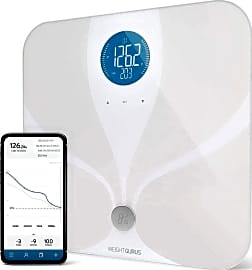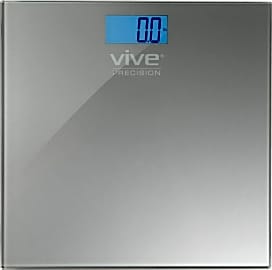The 10 Best Weight Scales

This wiki has been updated 40 times since it was first published in March of 2015. Back in the day, mechanical pressure and an analog dial could give you a ballpark figure for your weight. Times have changed, however, so we've produced a selection of bathroom scales that boast state-of-the-art features, like BMI readings and mobile device syncing. Most importantly, though, they're all durable, so they can take it when you punch them right in their smug, lying faces. When users buy our independently chosen editorial recommendations, we may earn commissions to help fund the Wiki.
Editor's Notes
April 07, 2020:
If you're trying to stay on top of your weight, the last thing you need is an inaccurate scale, which is why we've removed the iDoo Ultra-Wide. And even though the Etekcity Digital is quite popular, we've removed it as well, since it has a disconcerting tendency to shatter. Of course, all glass models can potentially fail in the same way, so if you choose one of these, like the Renpho Smart, you'll want to treat it carefully. Also, the Renpho model and others that offer body fat feedback, including the Withings Body+, use bioelectrical impedance analysis, which may not be safe for those with an electronic cardiac device, such as a pacemaker.
As for top picks, we have kept both the Innotech LCD and the Tanita HD-351. These are straightforward, reliable devices that just about anyone can figure out how to use. We've also opted to add an analog model at this time, the Health O Meter Oversized. Many tech-savvy modern users will find it too much of a throwback, but for many older users, it's a helpful choice. On the more tech-heavy side of the spectrum, we've added the Fitbit Aria 2, a BMI scale that offers both Bluetooth and Wi-Fi connectivity. Unfortunately, the latter can be somewhat finicky, so if you're the type who is quick to impatience, this model might be too frustrating. There's also the Greater Goods WiFi, which aims to be exceedingly straightforward to use. Some find its app to be frustrating, though.
Special Honors
Shapa Scale If you've become tired of watching your weight bounce up and down, then the highly advanced Shapa Scale may be the way to go. Instead of showing you numbers, it uses a five-color scale to represent your weight fluctuations in a motivational manner. You track this and other fun metrics, such as personalized missions, in the app, but you'll need to invest in a yearly subscription to use the platform. myshapa.com
Detecto Apex-SH For busy medical practices, the Detecto Apex-SH is a big help and a time-saver, as this digital model has eye-level readings and a touchless sonar height rod. It has plenty of little touches that make it a breeze to operate, including a clear LCD readout and the choice of AC or battery-powered operation. detecto.com
Brecknell MS1000 The Brecknell MS1000 was created for bariatric users as well as for those with limited mobility; it boasts both a sturdy handrail and a smooth surface that accommodates wheelchairs. Its overall capacity is 1,000 pounds, offered in half-pound increments. brecknellscales.com
Measure Your Mass With Crystalline Accuracy
Before we figure out how a scale measures your weight, it helps to understand what weight actually is.
It's a dreaded moment for most people getting their annual or biannual physical. The nice nurse asks you to hop up on the scale. She has your chart in her hands and a little dollar store pen with flowers on it. The scale, a beam-extended balance scale like an old Roman steelyard, seems to smile at you knowingly. You hop on and the balance arm clatters against the top of the stopper. Then, the nurse makes a flattering assumption about your weight, only sliding the large counterweight out just so far, and pushing the smaller counterweight inch-by-inch toward the end of the arm.
The arm still clings mockingly to the top of the stopper, and you wince as the nurse reaches for the large counterweight once again, sliding you a solid 50 lbs. to the right. A few minor adjustments to the small counterweight, and your shame, the result of immeasurable holiday indulgences and unfulfilled resolutions, has a measurable number.
But how exactly does the scale know what you weigh in the first place? Well, that depends on the type of scale in question, but we have only one type of scale on our list–the most accurate type–to discuss.
Before we figure out how a scale measures your weight, it helps to understand what weight actually is. Technically speaking, these scales measure mass, not weight. Mass is the actual presence of matter as measured in kilograms or pounds, whereas weight is a measure of the gravitational force enacted upon a mass. Since our measurements for weight and mass are conducted on Earth (where weight is relatively consistent), we've rather easily swapped the terms.
However, if you measure your dog's weight on Earth at 60 lbs., the big guy would only weigh 10 lbs. on the moon, where the gravitational force is 1/6 that of the Earth. His mass (I'll measure in kilograms here to help illustrate the difference) would be 27.22 kg on Earth and on the moon.
Older scales operated as counterweight balances with proven counterweights, or with springs whose pressure had been calibrated to translate tension into a mass readout. The scales on our list, however, utilize something called the piezoelectric effect to calculate your mass.
Piezoelectricity is a current produced by a crystal under pressure. Normally, a crystal's lattice structure is electrically neutral, its atoms arranged just so to maintain its neutrality. When you apply pressure to it, its atomic structure shifts, causing disturbances in its current that manifest as positive and negative charges at opposite ends of the crystal. The greater the pressure, the greater the charge.
When you step on a modern bathroom scale, your mass pressurizes a crystal inside a piezoelectric transducer, which translates the current output relative to your mass pressure into a readout in kilograms or pounds.
Weighing Your Options
If you've ever owned a piece of home exercise equipment, you know the feelings it induces when you walk by it, especially if you haven't used it in a while. You experience guilt and anxiety over your poor workout habits, as well as regret, perhaps, over the purchase.
Style, of course, is just one of the elements up for consideration among these scales.
Now, a scale isn't anywhere near as financially dangerous of an investment as a stationary bike or a treadmill might be, but it can cause within you similar feelings of resistance and resentment. That's why it's so important that the scale you select attracts you to it one way or another.
Most people keep their scales in the bathroom, and the bathroom often receives the least attention when it comes to home decorating. That means your scale could easily clash with the decor of the space, further souring your opinion of it and making it less likely that you're going to go near it.
I recommend keeping the scale in your bedroom, where you can jump on it first thing every morning. You'll have greater consistency in your weigh-ins, and you can find a model that suits the space you've spent a lot more time thoughtfully decorating.
Style, of course, is just one of the elements up for consideration among these scales. There are features to note as well, like smartphone connectivity and available apps for weight tracking and goal setting, as well as BMI measurements, display visibility, and weight limitations.
A Balanced Historical Narrative
The scale as we know it grew out of necessity among traders some 4,000 years ago. Imagine you were a merchant in those days dealing with oddly shaped goods like nuggets of precious metals throughout the Indus River valley. It wouldn't be quite fair to simply count the goods at hand, and they weren't of sufficiently uniform shape for you to measure their dimensions.
You could, however, compare them by weight to a quantity of the same goods sold for a set value, if only you had a machine for the task. Well, by simply hanging two plates from a beam strung by its center across a vertical post, you've created the world's first balance scale.
Much smaller versions of these larger, industrial scales developed quickly, and the Roman steeelyard came about as the predecessor to our modern balance scales some centuries later.
A pair of French physicists discovered the piezoelectric properties of crystals in the late 1800s, and their application for the purposes of digital mass measurement followed many decades later.















